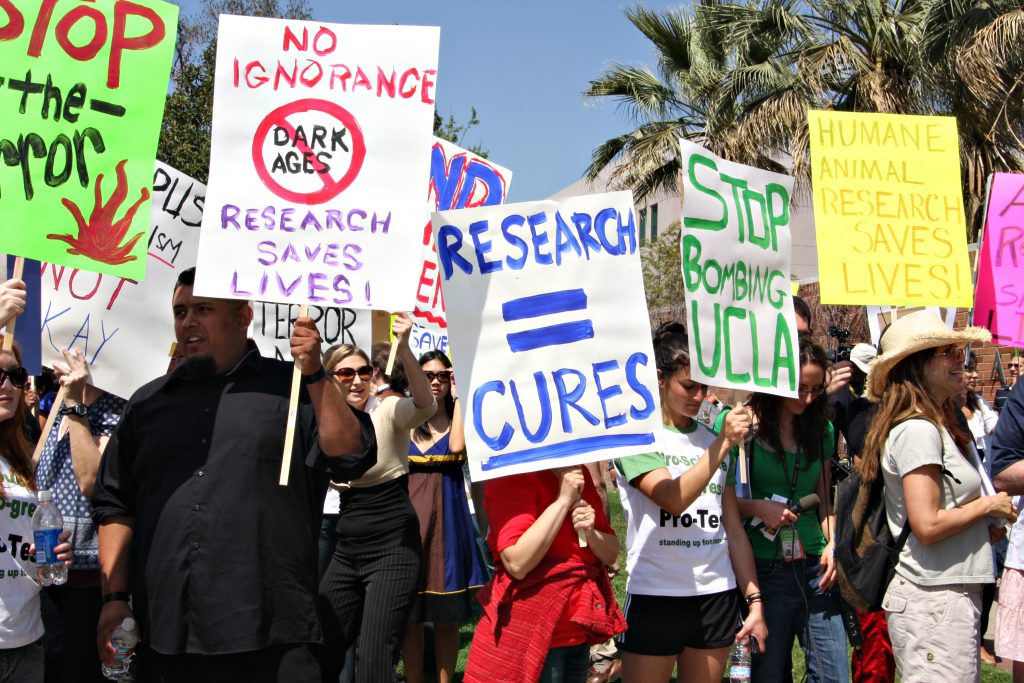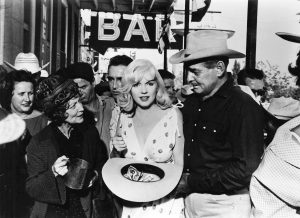Many people may not know this, but animal research has played an important role in almost every major medical advancement of the last century. The list includes antibiotics, blood transfusions, chemotherapy, dialysis, insulin, organ transplantation, heart bypass surgery, joint replacement, vaccinations, how a cancer gene works, new vaccines, and many more treatments that help stop suffering.1 These treatments are based on knowledge attained through research with lab animals. We have been able to learn and understand a great deal in the field of science and medicine through this testing; however, it has been at the expense of innocent animals. Although there are alternatives to animal testing, living organisms are very complex, and the only way to learn more is through research on other complex organisms that possess the same traits.
The many discoveries that have occurred, based on animal testing in the nineteenth century, have had a significant impact on how we live and view medicine. There are still a lot of questions, and even unknown questions in the field of science and medicine, that can benefit us in the same way they have in the past; therefore, animal testing should be continued for this purpose only. There are laws that protect animals and the amount that can be used and how they are treated to prevent cruelty. Many people who test on animals conduct their research with the obligation to keeping the animal safe. Their research uses as few animals as possible, and only when necessary, and in designed experiments that yield valid results and use the best possible methods and treatments.

Animal experiments were used in the discovery of anesthesia. Humphrey Davy demonstrated that nitrous oxide produced a reversible state of unconsciousness in animals. Through many trials, Davy led to the conclusion that animals could survive for long periods in an atmosphere of nitrous oxide mixed with air, and he consistently inhaled the gas himself. He noted on one trial that the gas actually relieved his toothache. In his book, published in 1800, Davy concludes: “As nitrous oxide in its extensive operation appears capable of destroying physical pain, it may probably be used with advantage during surgical operations in which no great effusion of blood takes place.”2 Later on, in the 1820s, Dr. Henry Hickman continued the experiments a stage further by performing surgery on animals under a state of carbon dioxide or nitrous oxide. Hickman tried to interest the medical field in the possibility of preventing pain during surgery by inhalation of these gases. However, he was ignored. More than twenty years later, the dentist Horace Wells, under nitrous oxide anesthesia, had a wisdom tooth removed by his partner Riggs. The nitrous oxide was administered by Quincy Colton, who was a medical student making his living by exploring the effects of laughing gas on members of the audience at stage shows.3 Before the laughing gas parties or ether frolic in the 1840s, the work of perfecting general anesthesia was already in play and being tested on animals.

Another critical discovery, very prominent in the lives of many today, is insulin. Studies using experimentally-induced animal models of diabetes were done to discover that insulin could be used to treat diabetes.4 The experiments began in 1921 by Frederick Banting and Charles Best. They began experimenting by removing the pancreas from a dog. The dog became thirsty, drank lots of water, and urinated more often. The dog became weaker and weaker. They found that this was due to the removal of sugars from the urine of the dog, whose pancreas had been previously removed, which is a typical animal model of diabetes. Experimenting on another dog, Banting and Best surgically ligated the pancreas, which stopped the flow of nourishment. This was so that the pancreas degenerated. After some time, they removed the pancreas, sliced it up, and froze the pieces in a mixture of water and salts.5 When the pieces were half frozen, they were ground up and filtered. The isolated substance was named “isletin.” This extract was then injected into the diabetic dog. Its blood glucose level dropped, and it seemed healthier and stronger. By giving a diabetic dog a few injections a day, Banting and Best could keep it healthy and free of symptoms.6 With continuing research, however, the extracts were found to be toxic. This caused a serious fever in both the dogs and diabetic patients. A biochemist named James Collip partnered with them and prepared insulin from the pancreas’ of cows and pigs. James Collip used alcohol to extract insulin, which produced several different protein solutions. He then needed to find out how much insulin was present in each solution. This was done by measuring their activity by injecting each solution into rabbits and monitoring their blood sugar levels. Collip developed a measure of activity based on the ability of the extract to lower blood sugar in the rabbit, which was used to standardize extracts. The three scientists, Collip, Banting, and Best’s extracts were used successfully in dogs and then in patients in 1922 with exceptional results. Millions today depend on this discovery, because insulin helps keeps blood sugar levels from getting too high or too low. Insulin regulates how the body uses and stores glucose and fat, and many of the body’s cells rely on it to take glucose from the blood for energy. It is very important and many people who have diabetes depend on this discovery.

Moreover, like many medical advances, the making of the heart-lung machine depended heavily on animal research.7 The cardiopulmonary bypass pump, or heart-lung machine, can take on the role of the heart and lungs during cardiac surgery. Opening up a person and being able to operate on a heart is extremely difficult and requires precise movements. As with any surgery, any wrong move or wrong cut can cause severe damage and even death. The machine allows for blood to bypass the heart while surgeons work. It is attached to the veins that feed the heart and to the arteries that leave it, where it draws blood from a patient just before it reaches the heart.8 In 1931, John Gibbon began to investigate the possibility of building an external device that could do the job of the heart and lungs for a short period of time. The research initially began using cats and developing a machine that could replace the function of a cat’s heart and lungs for twenty minutes.9 Unfortunately, not many of the cats survived longer that twenty-three days after surgery. Gibbon’s World War II army service in the China-Burma-INBM Theater temporarily interrupted his research. The research then continued with dogs, where initially the survival rates were low. He used a new series of experiments with dogs in the 1950s, using IBM-built machines. The new device used a new method of cascading the blood down a thin sheet of film for oxygenation, instead of the original technique that could potentially damage blood corpuscles. These experiments revealed the need to add filters to the heart-lung device to prevent blood clots. The dogs began surviving and the heart-lung machine was eventually prepared for use in humans. In 1953, the first successful operation on a human, using the heart-lung machine, was performed. Cecelia Bavolek underwent an open-heart bypass surgery, where the machine totally supported her heart and lung functions for more than half the duration.10 Today, this machine, which was perfected through many animal experiments, is commonly used to do the job of the heart and lungs for many hours, allowing for complex cardiac surgeries to take place. This machine is also used in keeping patients alive during heart transplants, and supported premature babies.
Animal testing has helped researchers discover or improve drugs and treatments, which have improved health and medicine. As mentioned, many medical treatments that many people heavily depend on today have been made possible by animal testing. Scientists and researchers are, of course, not allowed to experiment on humans, so the other route to go is on animals. In fact, 71 of the Nobel Prizes for Medicine won in the last 103 years were awarded to scientists who used animals in their research. There is still a lot to learn in the field of science and medicine, so animal research is still necessary in order for there to be advances.
- Salem Press Encyclopedia, January 2016, s.v. “Animal Testing,” by Joel McClellan. ↵
- R. Sharpe, The Cruel Deception, Chemical and Philosophical, The Chiefly Concerning Nitrous Oxide (Johnson: London, 1800), 159. ↵
- Thomson Guedes, The Self-trained pioneer Anesthesiology (JC, 1956), 93. ↵
- Michael Bliss, The Discovery of insulin (Chicago: University of Chicago Press, 2007), 304. ↵
- Subbroto Kumar Saha, “Recent Advances in Disease Modeling and Drug Discovery for Diabetes Mellitus Using Animals,” International Journal of Molecular Sciences 17, no. 2 (2016): 14. ↵
- Nobel Media, February 2009, s.v. “The Discovery of Insulin.” ↵
- “Animal Testing is crucial for science,” The Belfast Telegraph (Belfast, Northern Ireland 2016). ↵
- Andreia Cristina Passaroni, “Cardiopulmonary bypass: development of John Gibbon’s heart-lung machine,” The Brazilian Journal of Cardiovascular Surgery 30, no. 2 (2015): 238. ↵
- Andreia Cristina Passaroni, “Cardiopulmonary bypass: development of John Gibbon’s heart-lung machine,” Brazilian Journal of Cardiovascular Surgery 30, no. 2 (2015): 238. ↵
- Walter Gomes, “The Brazilian Registry of Adult Patient Undergoing Cardiovascular Surgery, the Bypass Project,” Brazilian Journal of Cardiovascular Surgery 32, no.2 (April 2017): 73. ↵



82 comments
Isaac Rodriguez
Although a controversial topic, we wouldn’t have the medical advancements we have today without animal research. Last year, I learned about the ethics and legality involved with animal research. There are animal welfare laws in place to prevent unethical means of research. In my opinion, animal research is okay if it is for the greater good. In situations like testing makeup products, I disagree.
Elias Garza
I enjoyed this article very much as it helped me have a better view on animal testing. I have a soft spot for animals and I hate to see them is such horrible conditions, such as animal testing. However, I do believe is some situations animal testing should be encouraged. There should be boundaries to such experiments and this article conveys them well.
Tyler Thompson
There are many arguments about the treatment of animals, especially for medical use. Although I personally disagree with the use of animals, we would not have many of the medical advances we have today without them. I agree with the author in saying that they should come up with newer methods that are safer, and less painful for the animal subjects. Science now a days is a lot more advanced than before, and I’m sure alternative methods could be used.
Destiny Flores
This article was incredibly informing and factious. I feel pretty strongly about animal rights but I’m personally on the line when it comes to controversial topics such as this. In cases like this, it isn’t just black and white and its complicated. The viewpoint differs on the scenario. I believe yes, animal test is necessary, but should be kept 110% humane at all times. Most of these animals feel pain and fear just like humans do and that important to keep in mind.
Natalie Childs
This was an incredibly well written article. The author did a great job of remaining unbiased and presenting facts and studies in a way to support her thesis. The studies that she used are very much life and death situations and the advancements made would not have been made near as quickly, or at all, without the help of these animals. The use of animals for testing of these procedures is what saves many, many lives today.
Kimberly Simmons
An ideal situation would be one where humans aren’t forced to test on animals, yet still get the same results. Unfortunately, that’s simply not how the world works. Without animal testing we would not have things like insulin, anesthesia, heart machines, and much more, as described in the article. I love animals, so though testing on them is a touchy subject, it is necessary to do so for medical advancement.
Carlos Sandoval
This article gives so many good points on animal testing and it proved that there is much more to the science. I agree with animal testing being important because without it we wouldn’t have the advances in medicine that we have today. I feel bad for the animals that they have to go through it, but I know it is for the better and if they ever find another way to test I think they should do it. Another thing, it is mind blowing to read about how their trials went and what they had to do.
Joshua Castro
I have understood the importance of using animals for research in medicine and this article really emphasizes the benefits of doing so. I was not aware that the study to develop insulin was initiated with the study of a dog and was very intrigued once I read about this. The use of animals in medical research is extremely beneficial because many of their physical traits are similar to those of humans. They have contributed to a wide variety of medicines and medical devices that are necessary for the preservation of the human population.
Anna Guaderrama
I’m so happy you wrote this article! I feel like all the time, people want to definitely stand up for animals because of how inhumane and cruel the words ‘animal testing’ can sound, but like with everything else there’s always another side to everything that really needs to be looked at. Yes, it can be easy to say animal testing shouldn’t exist but it’s important to note the medical/scientific breakthroughs that have been made USING animal testing. I personally don’t think it’s just a black or white field, there’s many grey areas and actually, a lot of animals live really good lives up until they retire…aside from first thought it’s not just 100% animal cruelty. Although alternatives exist, research with time has shown again and again how beneficial it is in some of these medical discoveries. It’s not something unnecessary like using animal testing with makeup and skin care products…these are treatments, medicines, etc. that are meant to help other people.
Alexander Cruz
Testing on animals isn’t something that anyone WANTS to do. Scientists do not enjoy this but they do it for a very good reason. I agree with many points in this article. It is interesting to learn the history of this practice and comforting to see how far it has come. I do hope one day we may find an alternative, but will always love animals for services they provide us.
-AC